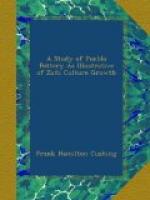552.—Native painting of sea serpent, showing space-line from mouth
to heart 515
553.—The fret of basket decoration 516
554.—The fret of pottery decoration 516
555.—Scroll as evolved from fret in pottery decoration 516
556.—Ancient Pueblo “medicine-jar” 517
557.—Decoration of above compared with modern Moki rain symbol 517
558.—Zuni prayer-meal bowl illustrating symbolism in form and
decoration 518
559.—Native paintings of sacred butterfly 519
560.—Native painting of sacred migratory “summer bird” 519
561.—Rectangular or Iroquois type of earthen vessel 519
562.—Kidney-shaped type of vessel of Nicaragua 520
563.—Iroquois bark vessel, showing angles of juncture 520
564.—Porcupine quill decoration on bark vessel, for comparison
with Fig. 561 521
~~~
* * * * *
A study of pueblo pottery as illustrative
of
Zuni culture-growth.
* * * * *
By Frank H. Cushing.
* * * * *
HABITATIONS AFFECTED BY ENVIRONMENT.
It is conceded that the peculiarities of a culture-status are due chiefly to the necessities encountered during its development. In this sense the Pueblo phase of life was, like the Egyptian, the product of a desert environment. Given that a tribe or stock of people is weak, they will be encroached upon by neighboring stronger tribes, and driven to new surroundings if not subdued. Such we may believe was the influence which led the ancestors of the Pueblo tribes to adopt an almost waterless area for their habitat.
It is apparent at least that they entered the country wherein their remains occur while comparatively a rude people, and worked out there almost wholly their incipient civilization. Of this there is important linguistic evidence.
[Illustration: Fig. 490.—A Navajo hut.]
A Navajo hogan, or hut, is a beehive-shaped or conical structure (see Fig. 490) of sticks and turf or earth, sometimes even of stones chinked with mud. Yet its modern Zuni name is ham’ pon ne, from ha we, dried brush, sprigs or leaves; and po an ne, covering, shelter or roof (po a to place over and ne the nominal suffix); which, interpreted, signifies a “brush or leaf shelter.” This leads to the inference that the temporary shelter with which the Zunis were acquainted when they formulated the name here given, presumably in their earliest condition, was in shape like the Navajo hogan, but in material, of brush or like perishable substance.




